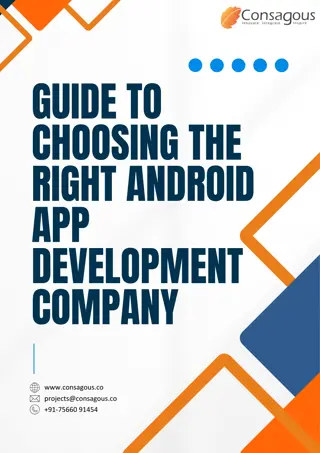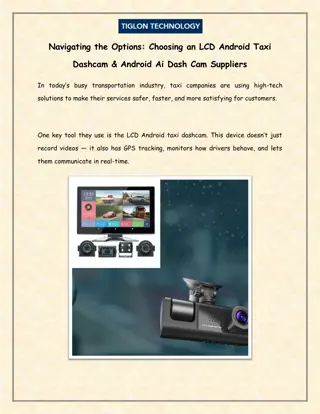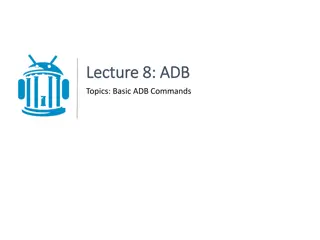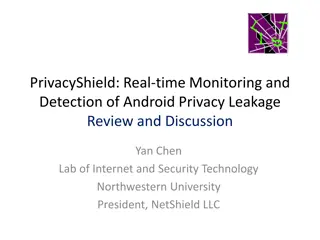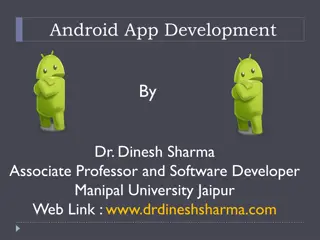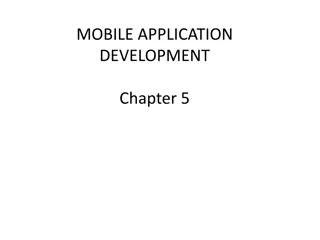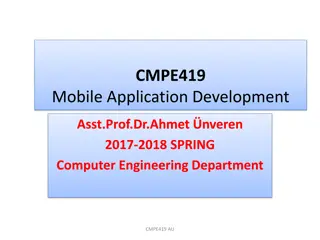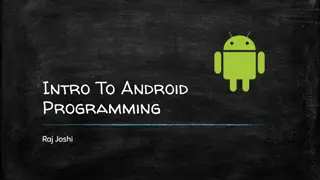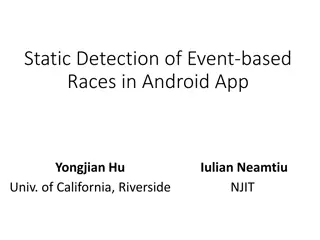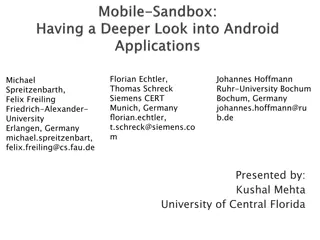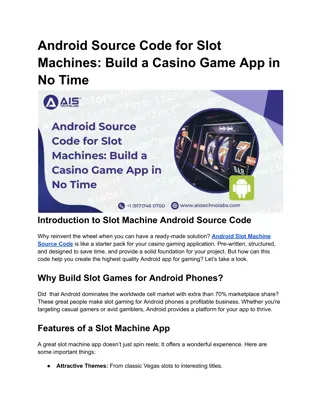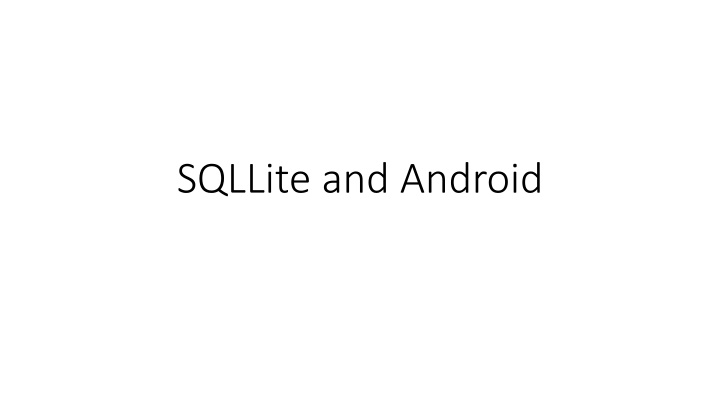
SQLite in Android Development
"Explore the world of SQLite in Android development, from its embedded RDBMS capabilities to managing databases using the android.database.sqlite classes. Learn about storage classes, creating databases, and utilizing SQLite methods efficiently."
Download Presentation

Please find below an Image/Link to download the presentation.
The content on the website is provided AS IS for your information and personal use only. It may not be sold, licensed, or shared on other websites without obtaining consent from the author. If you encounter any issues during the download, it is possible that the publisher has removed the file from their server.
You are allowed to download the files provided on this website for personal or commercial use, subject to the condition that they are used lawfully. All files are the property of their respective owners.
The content on the website is provided AS IS for your information and personal use only. It may not be sold, licensed, or shared on other websites without obtaining consent from the author.
E N D
Presentation Transcript
SQLLite Embedded RDBMS ACID Compliant Size about 257 Kbytes Not a client/server architecture Accessed via function calls from the application Writing (insert, update, delete) locks the database, queries can be done in parallel
SQLLite Datastore single, cross platform file (kinda like an MS Access DB) Definitions Tables Indicies Data
Storage classes NULL null value INTEGER - signed integer, stored in 1, 2, 3, 4, 6, or 8 bytes depending on the magnitude of the value REAL - a floating point value, 8-byte IEEE floating point number. TEXT - text string, stored using the database encoding (UTF-8, UTF-16BE or UTF- 16LE). BLOB. The value is a blob of data, stored exactly as it was input.
android.database.sqlite Contains the SQLite database management classes that an application would use to manage its own private database.
android.database.sqlite - Classes SQLiteCloseable - An object created from a SQLiteDatabase that can be closed. SQLiteCursor - A Cursor implementation that exposes results from a query on a SQLiteDatabase. SQLiteDatabase - Exposes methods to manage a SQLite database. SQLiteOpenHelper - A helper class to manage database creation and version management. SQLiteProgram - A base class for compiled SQLite programs. SQLiteQuery - A SQLite program that represents a query that reads the resulting rows into a CursorWindow. SQLiteQueryBuilder - a convenience class that helps build SQL queries to be sent to SQLiteDatabase objects. SQLiteStatement - A pre-compiled statement against a SQLiteDatabase that can be reused.
android.database.sqlite.SQLiteDatabase Contains the methods for: creating, opening, closing, inserting, updating, deleting and quering an SQLite database These methods are similar to JDBC but more method oriented than what we see with JDBC (remember there is not a RDBMS server running)
openOrCreateDatabase( ) This method will open an existing database or create one in the application data area import android.database.sqlite.SQLiteDatabase; SQLiteDatabase myDatabase; myDatabase = openOrCreateDatabase ("my_sqlite_database.db" , SQLiteDatabase.CREATE_IF_NECESSARY , null);
SQLite Database Properties Important database configuration options include: version, locale, and thread-safe locking. import java.util.Locale; myDatabase.setVersion(1); myDatabase.setLockingEnabled(true); myDatabase.SetLocale(Locale.getDefault());
Creating Tables Create a static string containing the SQLite CREATE statement, use the execSQL( ) method to execute it. String createAuthor = "CREAT TABLE authors ( id INTEGER PRIMARY KEY AUTOINCREMENT, fname TEXT, lname TEXT); myDatabase.execSQL(createAuthor);
insert( ) long insert(String table, String nullColumnHack, ContentValues values) import android.content.ContentValues; ContentValues values = new ContentValues( ); values.put("firstname" , "J.K."); values.put("lastname" , "Rowling"); long newAuthorID = myDatabase.insert("tbl_authors" , "" , values);
update( ) int update(String table, ContentValues values, String whereClause, String[ ] whereArgs) public void updateBookTitle(Integer bookId, String newTitle) { ContentValues values = new ContentValues(); values.put("title" , newTitle); myDatabase.update("tbl_books" , values , "id=?" , new String[ ] {bookId.toString() } ); }
delete( ) int delete(String table, String whereClause, String[] whereArgs) public void deleteBook(Integer bookId) { myDatabase.delete("tbl_books" , "id=?" , new String[ ] { bookId.toString( ) } ) ; }
android.database http://developer.android.com/reference/android/database/package- summary.html Contains classes and interfaces to explore data returned through a content provider. The main thing you are going to use here is the Cursor interface to get the data from the resultset that is returned by a query http://developer.android.com/reference/android/database/Cursor.html
Queries Method of SQLiteDatabase class and performs queries on the DB and returns the results in a Cursor object Cursor c = mdb.query(p1,p2,p3,p4,p5,p6,p7) p1 ; Table name (String) p2 ; Columns to return (String array) p3 ; WHERE clause (use null for all, ?s for selection args) p4 ; selection arg values for ?s of WHERE clause p5 ; GROUP BY ( null for none) (String) p6 ; HAVING (null unless GROUP BY requires one) (String) p7 ; ORDER BY (null for default ordering)(String) p8 ; LIMIT (null for no limit) (String)
Simple Queries SQL - "SELECT * FROM ABC;" SQLite - Cursor c = mdb.query(abc,null,null,null,null,null,null); SQL - "SELECT * FROM ABC WHERE C1=5" SQLite - Cursor c = mdb.query( abc,null,"c1=?" , new String[ ] {"5"},null,null,null); SQL "SELECT title,id FROM BOOKS ORDER BY title ASC" SQLite String colsToReturn [ ] {"title","id"}; String sortOrder = "title ASC"; Cursor c = mdb.query("books",colsToReturn, null,null,null,null,sortOrder);


